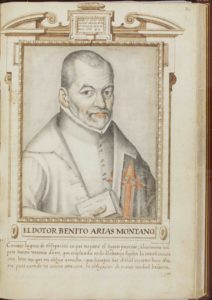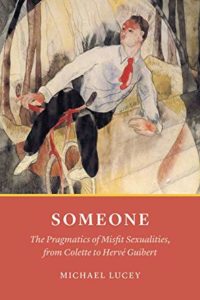Francisco Pacheco’s Book of True Portraits: Humanism, Art, and the Practice of “Visual History”
by Randall Meissen
 Francisco Pacheco, portrait of Benito Arias Montano, c. 1580–1644. IB 15654, Biblioteca Lázaro Galdiano, Madrid.
Francisco Pacheco, portrait of Benito Arias Montano, c. 1580–1644. IB 15654, Biblioteca Lázaro Galdiano, Madrid.
The essay begins:
Pacheco was the foremost art theorist of his generation, a longtime member of Seville’s famed humanistic academy, and both father-in-law and mentor to two of the most prominent artists of the Spanish baroque, Alonzo Cano (1601–67) and Diego Velázquez (1599–1660). Pacheco’s unfinished manuscript book, Libro de descripción de verdaderos retratos, de illustres y memorables varones (Book of description of true portraits of illustrious and memorable men), currently held at the Lázaro Galdiano Museum in Madrid, was a work in progress for most of his professional life, as he gradually compiled it from 1599 until his death in 1644. The manuscript consists of fifty-six portrait drawings by Pacheco and forty-four short biographical texts on authors, artists, ecclesiastics, and other men of accomplishment. Most of the biographies are straightforward, consisting of a description of the individual’s education, notable military or literary achievements, any written or artistic works, connection to Seville (however slight), and occasional brief anecdotes highlighting the individual’s moral character.
In his treatise Arte de la pintura (On the art of painting; Seville, 1649), Pacheco indicated that he had drawn more than 170 portraits in black and red pencil with the intention of selecting from them up to one hundred eminent individuals representing all fields of learning. The physical construction of the Libro de retratos, evident from several of the unfinished sections, demonstrates Pacheco’s process, as he described it, of drawing, retaining, and selecting the portraits over many years. Seven loose, single-sheet portrait-biographies that he chose not to incorporate into his manuscript book still survive at the library of the Palacio real in Madrid. Pacheco cut each portrait from its original sheet, pasted it onto a sheet of the manuscript, and then framed it with architectural ornamentation drawn in ink and washed in sepia tones. At the top of each finished frame, Pacheco added a biblical verse, and along the lower edge he placed the individual’s name in capitals.
A completed portrait and biography in Pacheco’s Libro consisted of a single sheet folded in half to form two folios. A succinct two- to three-page biographical description followed each finished portrait and often concluded with an epithet or poem. Most of the biographies recorded the death of the individual, and some portraits of individuals who survived Pacheco have blank pages where the biography would go, a detail that suggests Pacheco avoided writing a person’s definitive biography until the ink upon the pages of their life had dried.
Pacheco chose to adopt a genre of historical writing with a classical genealogy for the preservation of Seville’s recent historical memory. The De viris illustribus (“on illustrious men”) genre, which can be traced back to Plutarch and Cicero, experienced a renewed popularity during the Renaissance. Pacheco was familiar with the illustrated editions of famous men by the Italian humanist Paolo Giovio (1483–1552) and the subsequent work on the lives of artists by Giorgio Vasari (1511–74). Pacheco lamented that although in other nations, “particularly Italy,” art itself was honored by those who wrote the lives of illustrious artists, “only our nation lacks that praiseworthy endeavor,” and artists themselves were to blame. Apparently Pacheco took it upon himself to remedy this shortfall, and he was uniquely well suited for such an undertaking. Unlike Giovio or Vasari, who depended on artists and engravers to translate their projects into print, Pacheco had complete control over both the text and the images of his manuscript book.
The Libro de retratos is in fact a visual history. In its recovery and preservation of a visual record of an illustrious past, it confirms that such a practice existed in Pacheco’s era. It was a practice manifested in a transmedial application of methods adapted from humanistic textual scholarship and early modern antiquarianism as they were applied to artistic media for the preservation and communication of historical knowledge. To understand his Libro it must be recognized that Pacheco constructed his images by basing them on other credible visual sources (employing a method I call visual philology). One might mistake the portraits for illustrations of the text, but instead the texts “illustrate” or describe the portraits, as Pacheco made explicit by titling the collection of works Book of Description of True Portraits.
His Libro is thus a useful object for exploring questions of material culture relevant to visual studies scholars, historians of the book, and early modernists. Pacheco’s claim to produce true portraits was closely related to the distinctive ways antiquarians and ecclesiastics of his era used material evidence to stake truth claims about the ancient world and about the virtuousness of historical personages, respectively. Pacheco attempted to show certain qualities of historical personages—such as prestige, prosperity, illustriousness, and holiness—that were tightly bound to display, pageantry, costume, and liturgy in Seville. My essay, then, will demonstrate how three intertwined visual cultures produced by the antiquarian reimagining of Seville’s Roman past, Catholic Counter-Reformation image theory, and the publishing conventions of Sevillian humanism shaped Pacheco’s expectations about how an illustrious past should look. Let’s consider first how Seville’s elites used reimagined classical imagery to celebrate the glory of their city and how Pacheco employed that visual vocabulary in his Libro. Continue reading …
Francisco Pacheco (1564–1644), the foremost Spanish art theorist of his generation, worked on his manuscript Libro de verdaderos retratos (Book of true portraits) for more than forty years. In this essay Randall Meissen addresses how the visual cultures of Pacheco’s Seville, especially the city’s reimagined imperial Roman past, Catholic Counter-Reformation image praxis, and visual conventions of Renaissance humanism, shaped Pacheco’s conception of how an illustrious past could be recovered and shown.
RANDALL MEISSEN is a PhD candidate in history at the University of Southern California and predoctoral fellow at the USC-Huntington Early Modern Studies Institute. He has held short-term fellowships at the Huntington Library in San Marino, California; the John Carter Brown Library in Providence, Rhode Island; and the Center for Medieval and Renaissance Studies at Saint Louis University in St. Louis, Missouri.

 Imagine trying to tell someone something about yourself and your desires for which there are no words. What if the mere attempt at expression was bound to misfire, to efface the truth of that ineluctable something?
Imagine trying to tell someone something about yourself and your desires for which there are no words. What if the mere attempt at expression was bound to misfire, to efface the truth of that ineluctable something?